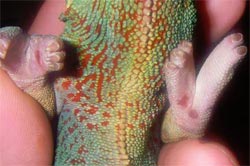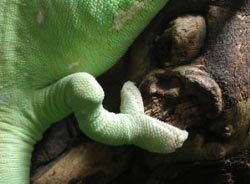Follow along with the video below to see how to install our site as a web app on your home screen.
Note: This feature may not be available in some browsers.
You should upgrade or use an alternative browser.
Legs & Feet

Some chameleons will develop sores on the bottom of their feet due to particular caging techniques. On non-screen cages, such as those made with chicken wire, chameleons may get abrasions from crawling on such materials. If the cage stays too moist, especially on the branches, a pododermatitis (skin infection of the feet) may form. Keep the environment dry to minimize further trauma to the feet and to prevent progression of minor lesions. If the sores are causing pain, having discharge or look like open wounds then a reptile veterinarian should be consulted. Progression can lead to joint or bone involvement, which become serious infections that are difficult to treat.
Common Symptoms: Feet: Redness, Irritation, Scabs, Open Wounds
Limping is often a sign of traumatic injury although an underlying health problem may be involved. Limping or fractures of the bones can be facilitated by low calcium levels or gout. If your chameleon is having trouble walking due to an injured leg or if the limping does not resolve on its own over a few days a reptile vet should be consulted.


Metabolic Bone Disease is unfortunately common among captive reptiles and the cause is frequently due to a lack of dietary calcium, imbalanced nutrition or improper artifical lighting specific to reptiles. To compensate for inadequate calcium absorption the body will pull calcium stores directly out of the bones so there is enough for critical functions like muscle movement and metabolism. The offshoot of this is that the bones become very weak and brittle. Signs of MBD include stunted growth, bent leg bones, fractures, double elbows or knees, grabbing at its own legs or head, decreased tongue usage, a soft jaw and the mouth not aligning or closing all the way. This is a very painful disease and if left unchecked will eventually kill the chameleon.
Damage from MBD cannot be reversed completely but the process can be stopped. The bones can heal over time with medication and proper husbandry, which includes access to proper UVB lighting combined with correcting any calcium imbalance. It is important to address early signs of MBD with your veterinarian to stop further damage.
Common Symptoms: Broken Bones, Double Leg Joints, Weakness, Stunted Growth, Grabbing Own Legs

Often wild caught chameleons will have missing toenails from the collection process. Captive chameleons can tear their nails on the screening of cages sometimes as well. The toenails usually do not grow back but often do not cause any long term damage. If the area around the missing toenail is swollen or has discharge then an infection may be present.

The swelling of a joint can indicate infection, injury or a condition called gout. Gout is a fairly common ailment and is the result of excess uric acid in the bloodstream. These excess uric acids and salts develop into crystals and build up in an animal's joints. There are two classifications for why excess uric acids form in the first place. Primary gout is usually caused by too much dietary protein. Secondary gout is more common with captive chameleons and is frequently caused by dehydration or renal dysfunction. This condition is very painful and unfortunately there is no effective treatment. Prevention with appropriate husbandry is the best defense against this disease. If the swelling is the result of infection then a sample of the fluid will need to be taken and antibiotics should be started. Sometimes surgery by a veterinarian is needed to clean out or remove the affected joint.
This is a serious problem that may require veterinary treatment quickly to correct the underlying issue before it's too late. A number of things could cause this behavior, but most likely the chameleon is suffering from illness, dehydration, metabolic disease or some other serious health problem. To learn more about the very important aspects of chameleon husbandry see the Chameleon Care Resources.
